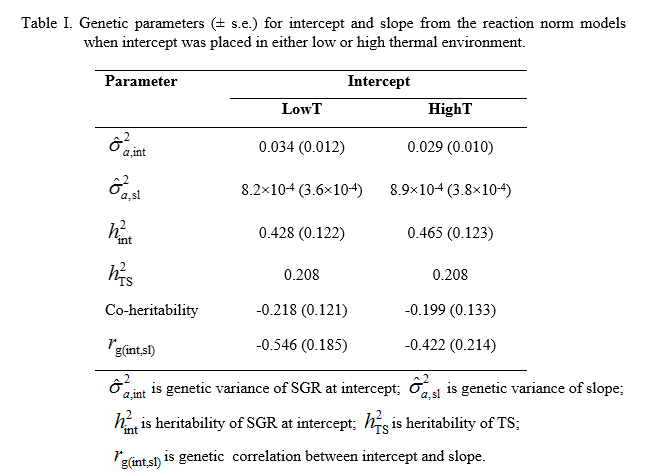GENETICS OF TEMPERATURE SENSITIVITY OF GROWTH IN ONE-YEAR-OLD RAINBOW TROUT
Introduction
Rainbow trout is an important cold-water aquaculture species that is distributed worldwide to various production environments. The diverse geographical locations of trout farms may involve considerable variation in environmental factors such as water temperature, which is of great importance for the performance and welfare of fish. Robust fish material thriving under different and suboptimal thermal conditions would thus be a desirable goal for selective breeding. Due to global warming, furthermore, there will probably be an increasing demand in fish farming sector for more heat-tolerant trout populations. The primary aim of this study was to assess the degree of heritable variation in growth responses of rainbow trout across different rearing temperatures and to find out whether temperature sensitivity (TS) of growth has the potential to be changed by selection. The degree of such environmental sensitivity for a genotype (e.g. family) can be quantified by the (linear) regression slope of a genotype's performance across an environmental gradient (De Jong, 1990).
Materials and methods
Using a split-family experimental setup, a total of 800 one-year-old id-tagged rainbow trout from 40 full-/half-sib groups derived from the Finnish national breeding program were reared at low (14.1±1.0°C; mean ± s.d.) and high (20.4±1.8°C) temperature for 70 days (from June 3th to August 12th 2014). The fish were fed ad libitum 6 h⋅d-1 with commercial trout feed. Individual body weights were recorded at the beginning (mean ± s.d.= 129±28 g, n = 800 fish) and end of the trial (516±98 g, n = 785).
The means of tank-specific feed intakes (FI, %⋅day-1, n = 8 tanks per temperature treatment) and feed conversion ratios (FCR, intake/gain), and individual specific growth rates (SGR, %⋅ day-1) were compared between the temperature treatments using linear mixed models in SAS 9.4. Second, the genetic correlation of SGR was estimated between the thermal environments using a multi-trait animal mixed model. Third, the additive genetic variation for SGR (i.e. intercept of reaction norm placed in either thermal environment) and its TS (defined as the slope of growth reaction norm between the thermal environments) was quantified using a reaction norm model (Sae-Lim et al., 2015ab). Lastly, the genetic correlation was estimated between SGR and its TS. All genetic models were performed using ASReml 3.0 (Gilmour et al., 2009).
Results
The fish at the lower temperature showed statistically lower FI (1.60±0.04 vs. 1.74±0.02; mean ± s.d.), better FCR (0.88±0.01 vs. 0.97±0.02) and faster growth (2.06±0.28 vs. 1.95±0.25), compared to their siblings at the higher temperature (p≤0.002). The genetic correlation of SGR between different temperatures was 0.51 (s.e. 0.20). Substantial additive genetic variance was found for TS of SGR, the heritability of TS being moderate and similar regardless of which environment was used for the intercept (Table I). Similarly, the co-heritability derived from selection index theory (i.e. another genetic parameter describing heritable variance of TS; Janssens, 1979) was moderately negative and of similar magnitude, irrespective of whether the intercept was placed in the low or high thermal environment (Table I). This further translated into moderate accuracies of TS selection for growth (rIH=0.36 for low and 0.29 for high thermal environment). The genetic correlation between SGR and its TS was significantly negative (-0.55 to -0.42; Table I).
Discussion and conclusion
The observed genetic correlation of SGR between different temperatures indicates remarkable re-ranking of genotypes across the thermal environments. The considerable amount of genetic variation in TS of growth implies a potential for response to selection and thus targeted genetic improvement on this trait. The negative genetic correlation between SGR (mean) and its TS suggests that selection for high growth rate in one environment will result in more temperature-sensitive fish. The presence of strong genotype-by-environment interaction together with negative genetic correlation between SGR and its TS warrant caution if selection decisions are only based on one thermal environment. Nevertheless, it seems possible to control the correlated genetic change of TS while selecting for fast growth across temperatures, especially if measurements from different environments are available and breeding values for reaction norm slope are directly included in selection indices.
References
De Jong, G. 1990. Quantitative genetics of reaction norms. Journal of Evolutionary Biology 3: 447-468.
Gilmour, A. R., B. J. Gogel, B. R. Cullis, and R. Thompson. 2009. ASReml user guide release 3.0. VSN International Ltd, Hernel Hempstead. 372pp.
Janssens, M. 1979. Coheritability: its relation to correlated response, linkage, and pleiotropy in cases of polygenic inheritance. Euphytica 28: 601-608.
Sae-Lim, P., B. Gjerde B, H. M. Nielsen, H. Mulder, and A. Kause. 2015a. A review of genotype-by-environment interaction and micro-environmental sensitivity in aquaculture species. Reviews in Aquaculture 7: 1-25.
Sae-Lim, P, H. Mulder, B. Gjerde, H. Koskinen, M. Lillehammer, and A. Kause. 2015b. Genetics of growth reaction norms in farmed rainbow trout. PLoS ONE 10(8): e0135133.
